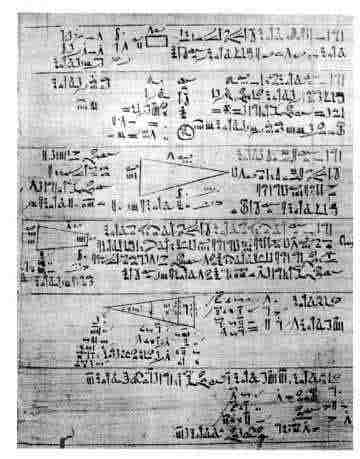The ancient Egyptians had many uses for mathematics whether it was for building, cooking, working out taxes, counting money, measuring straight lines or time, or for knowing when the Nile would flood. They used mathematics all the time in their everyday lives. Some of the people who used basic math were priests/priestesses, tax collectors, shopkeepers and cooks. Builders, masons, surveyors, and priests who were in charge of builders used a higher form of mathematics. There were two scrolls that acted like mathematical textbooks for the Egyptians, the Rhind Papyrus and the Moscow Papyrus.
 |
| Rhind Papyrus http://www.gap-system.org/~history/HistTopics/Egyptian_mathematics.html |
The Rhind Papyrus has 87 problems within it, some problems involve geometry such as problem 50: a round field has diameter 9 khet. What is its area? Other problems like number 56 gives an equation to find the angle of the slope of a pyramids face. Architects had also built into their structures right triangles that obeyed the theorem a²+ b²= c², a and b represent the two sides while c is the hypotenuse. Pythagoras himself studied in temples of the Nile Valley for 22 years; there could have been the source for the Pythagorean theorem.
The Egyptians knew addition, subtraction but only some multiplication and division. They had an interesting way of getting around the dilemma of multiplication and division that their number system created. They had methods of multiplication and division that only involved addition and they only would multiply or divide by two. An example of this would be 3 x 2 + 3 = 9 instead of 3 x 3 = 9.
Here is what their numbers looked like-
"1 =  2 =
2 = 
 3 =
3 = 

 4 =
4 = 



 2 =
2 = 
 3 =
3 = 

 4 =
4 = 



10 =  100 =
100 =  1,000 =
1,000 =  10,000 =
10,000 =  100,000 =
100,000 =  1,000,000 =
1,000,000 = 
 100 =
100 =  1,000 =
1,000 =  10,000 =
10,000 =  100,000 =
100,000 =  1,000,000 =
1,000,000 = 
As for fractions, 'r'  was used for the word 'part'. This means that r-10
was used for the word 'part'. This means that r-10 
 is equivalent to our 1/10.
is equivalent to our 1/10.
 was used for the word 'part'. This means that r-10
was used for the word 'part'. This means that r-10 
 is equivalent to our 1/10.
is equivalent to our 1/10.The Egyptian sign 'gs'  was used for the word 'side' or 'half' ½. The word 'hsb'
was used for the word 'side' or 'half' ½. The word 'hsb'  meant 'fraction', but it came to mean 'part-4' or ¼. 'rwy'
meant 'fraction', but it came to mean 'part-4' or ¼. 'rwy'  meant 'two parts out of three' 2/3, and 'khmt rw'
meant 'two parts out of three' 2/3, and 'khmt rw'  , though rare, was 'three parts out of four' 3/4."
, though rare, was 'three parts out of four' 3/4."
http://www.touregypt.net/featurestories/numbers.htm
 was used for the word 'side' or 'half' ½. The word 'hsb'
was used for the word 'side' or 'half' ½. The word 'hsb'  meant 'fraction', but it came to mean 'part-4' or ¼. 'rwy'
meant 'fraction', but it came to mean 'part-4' or ¼. 'rwy'  meant 'two parts out of three' 2/3, and 'khmt rw'
meant 'two parts out of three' 2/3, and 'khmt rw'  , though rare, was 'three parts out of four' 3/4."
, though rare, was 'three parts out of four' 3/4."http://www.touregypt.net/featurestories/numbers.htm
One of their greatest achievements involving mathematics was the building of the Great Pyramid of Khufu from the Fourth Dynasty. It was very geometrically precise with an almost perfect square base and sides that only differ from each other by less than 20 centimeters. There are around 2,300,000 giant stone blocks in the pyramid that are so closely placed together that the blade of a knife can not be fit between them. Mathematically there are discoveries about this pyramid that can either be deemed as accidental, coincidental or that the Egyptians knew more about the world than history thought.
"When using the Egyptian cubit the perimeter is 365.24 - the amount of days in the year.
When doubling the perimeter, the answer is equal to one minute of one degree at the equator.
The apex to base slant is equal to 600th of a degree of latitude.
The height x 10 to the power of 9 gives approximately the distance from the earth to the sun.
The perimeter divided by 2 x the height of the pyramid is equal to pi - 3.1416.
The weight of the pyramid x 10 to the power of 15 is equal to the approximate weight of the earth.
When the cross diagonals of the base are added together, the answer is equal to the amount of time (in years) that it takes for the earth's polar axis to go back to its original starting point - 25,286.6 years.
The measurements of the King's Chamber gives 2,square root(5),3 and 3,4,5 which are basic Pythagorean triangles."
Either way you look at it the Egyptians showed they had the means and the great minds to create a masterpiece that not even today we can replicate properly, even with our advanced mathematics and machinery.
http://www.touregypt.net/featurestories/numbers.htm
http://www.gap-system.org/~history/HistTopics/Egyptian_mathematics.html
"When us |
No comments:
Post a Comment